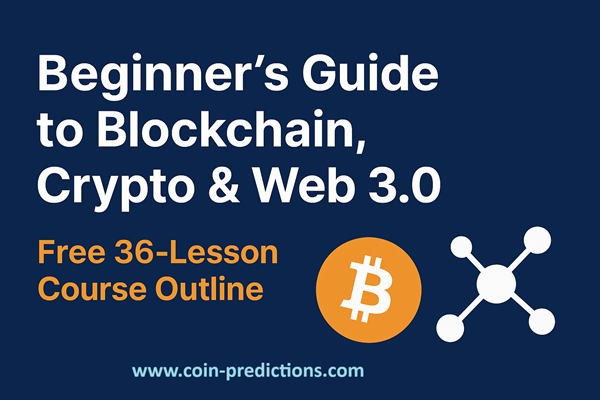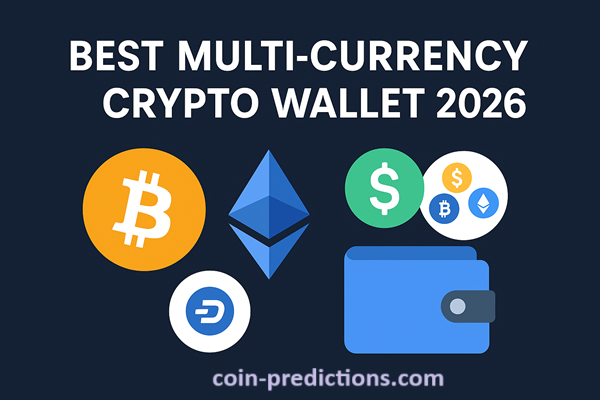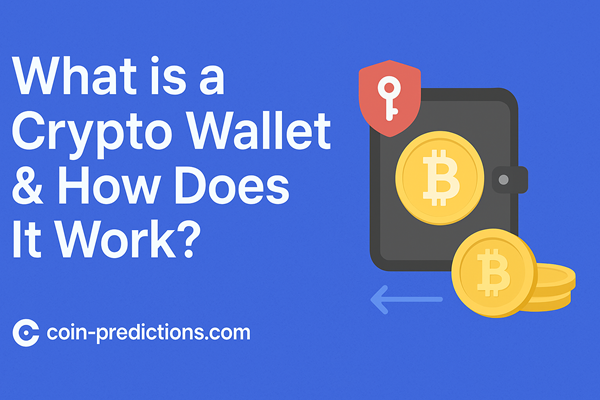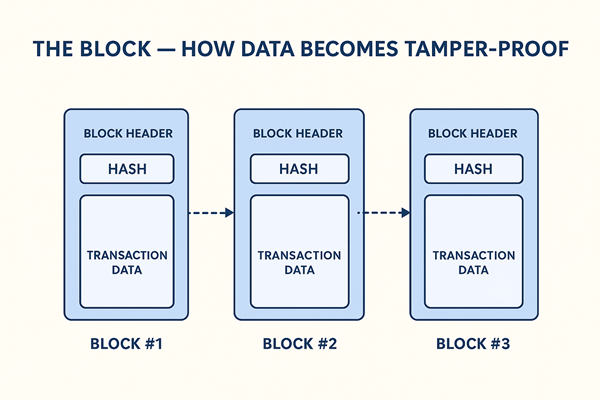Ultimate Starter Kit – Cryptocurrency & Blockchain LEARN — Course Outline (36 lessons)

What you’ll learn
- Beginner’s Guide to Blockchain Crypto & Web 3.0 (36 Lessons)
- Understand the fundamentals of blockchain technology, including how it works and how it is used in various industries.
- Gain an overview of cryptocurrencies, including how they are created, traded and stored.
- Learn how blockchain technology is used in Web 3.0, including its impact on decentralized applications and the future of the internet.
- Be able to express and communicate the concepts of blockchain, cryptocurrencies, and their role in Web 3.0.
Free Ultimate Starter Kit – Cryptocurrency & Blockchain LEARNing — Course Outline (36 lessons)
Beginner’s Guide to Blockchain, Crypto & Web 3.0 (36 Lessons) – Learn blockchain, cryptocurrencies & Web 3.0 from scratch. Explore basics, trading, wallets, DeFi & NFTs in this free 36-lesson beginner’s guide.
Part I — Blockchain Technology (Lessons 1–13)
Focused on fundamentals: how blockchains work, the building blocks and consensus mechanics.
- Introduction — Why Blockchain Matters
What this lesson does: High-level overview + course roadmap. - The Ledger — What a Distributed Ledger Actually Is
Intent: Explain immutable recordkeeping and ledgers vs databases. - Eliminating the Middleman — Decentralization Explained
Intent: Business/UX implications of removing trusted intermediaries. - Encryption Fundamentals — Keeping Data Private
Intent: Intro to asymmetric cryptography used in blockchains. - Hash Functions — The Building Block of Integrity
Intent: Why hashing matters and simple examples. - The Block — Structure & Contents
Intent: What’s inside a block and how transactions are packaged. - The Chain — Linking Blocks & Immutability
Intent: How blocks reference each other and why that secures history. - Client-Server vs Peer-to-Peer Networks
Intent: Compare architectures and explain peer discovery, propagation. - Consensus Protocols — PoW, PoS & Beyond
Intent: Compare major families of consensus and tradeoffs. - Validating Transactions — From Mempool to Block
Intent: Walk through transaction lifecycle and mempool behavior. - Identity & Signatures — Verifying Senders
Intent: How keys/signatures prove ownership and prevent fraud. - Mining / Block Proposals — How a Block Gets Chosen
Intent: Miner/validator incentives, block rewards and selection. - Longest Chain, Finality & Reorgs
Intent: Explain chain selection, forks, and finality guarantees.
Part II — Cryptocurrencies (Lessons 14–26)
Hands-on practical lessons about coins/tokens, trading, wallets and security.
- Coins vs Tokens — What’s the Difference?
Intent: Native chain currency vs token standards. - What Are Cryptocurrencies? Use Cases & Value Drivers
Intent: Where value comes from: utility, scarcity, network effects. - How Cryptocurrency Gets Its Value (Tokenomics 101)
Intent: Supply schedule, inflation, burns, and economic models. - Trading Cryptocurrencies — Basic Concepts
Intent: Orderbook, market vs limit orders, slippage. - Wallets — Types, Tradeoffs & Use Cases
Intent: Custodial vs non-custodial, hot vs cold explained. - Keys vs Addresses — The Technical Difference
Intent: Practical examples showing derivation & usage. - Mempools & How Transactions Queue
Intent: Why transactions wait and how fees/priorities work. - How Miners/Validators Choose Transactions
Intent: Fee markets, MEV basics and prioritization. - How Coins Are Introduced — Issuance & Distribution Models
Intent: ICOs, airdrops, inflationary vs deflationary models. - Proof-of-Stake Mechanics & Staking Basics
Intent: Validator selection, slashing, delegation. - Mining Pools, Delegation & Centralization Risks
Intent: Pool dynamics, risks and governance implications. - 51% Attacks & Network Security Threats
Intent: Attack vectors, historical examples and mitigations. - Exchanges & Order Types — Placing Your First Trade
Intent: CEX vs DEX, KYC, margin, and practical safety tips.
Part III — Blockchain & Web 3.0 (Lessons 27–36)
Applications, DeFi, dApps, NFTs and the future — product-level use and integration.
- Smart Contracts — Code that Runs on the Blockchain
Intent: What they are, how they execute, and why audits matter. - Tokens & Standards (ERC-20, ERC-721, etc.)
Intent: Token standards, fungibility and use-cases. - NFTs — What They Are & Where They Fit
Intent: Use-cases beyond art: identity, ownership proofs, gaming. - Decentralized Apps (dApps) — Anatomy & UX
Intent: Frontend <> wallet <> smart contract flows; common pitfalls. - DeFi Basics — Lending, Borrowing & AMMs
Intent: How liquidity pools work, impermanent loss basics. - Blockchain in Supply Chain Management
Intent: Traceability use-cases and real-world constraints. - Blockchain for Identity Management
Intent: Verifiable credentials, privacy, and practical adoption challenges. - Blockchain in Voting Systems & Governance
Intent: Transparency, secrecy tradeoffs and real-world experiments. - The Future of Blockchain — Scaling, Interoperability & Privacy
Intent: Layer-2s, rollups, bridges, zk & cross-chain ideas. - Capstone: Build Your First Trade / Deploy a Mini dApp
Intent: Hands-on walkthrough tying lessons together (use profit calculator + a small DeFi action).
Your Ultimate Beginner’s Guide to Blockchain, Cryptocurrency & Web 3.0
Requirements
- A basic understanding of computer systems and the internet is helpful but not essential.
- No technical expertise required—just curiosity and an eagerness to learn!
Introduction
Blockchain is one of the most talked-about technologies today, with the potential to reshape industries, finance, and the internet as we know it. But for most people, the technical terms and complex concepts can feel intimidating.
This guide breaks it down step by step, making blockchain easy to understand even if you have no technical background. By the end, you’ll have a clear foundation in blockchain technology, cryptocurrencies, and the emerging world of Web 3.0.
Module 1: Understanding Blockchain Technology
In this section, we’ll explore the core building blocks of blockchain:
- What is a blockchain? Ledgers, blocks, and chains explained simply
- How blockchain removes middlemen and increases trust
- Encryption & hash functions: the invisible glue that keeps blockchain secure
- Client-server vs. peer-to-peer networks
- How transactions are validated and verified
- Consensus protocols & miner roles (and why miners mine)
- The concept of the “longest chain” and why it matters
Module 2: The World of Cryptocurrencies
Once you understand blockchain, the next step is to see how it powers digital money:
- Coins vs. tokens – what’s the difference?
- How cryptocurrencies gain value and are traded
- Understanding wallets: keys vs. addresses
- What are mempools, and how do miners choose transactions?
- How new coins enter circulation
- Introduction to proof-of-stake, mining pools, and the 51% attack
Module 3: Blockchain & Web 3.0
Finally, we look ahead to where blockchain is taking us:
- Smart contracts & NFTs – beyond just digital currency
- Decentralized applications (DApps)
- Real-world use cases: supply chain, identity, and voting systems
- Decentralized finance (DeFi) and its opportunities
- The rise of Web 3.0 – a new internet powered by blockchain
Who Is This For?
This guide is perfect for:
- Beginners who want to understand blockchain without coding
- Students and professionals exploring blockchain careers
- Entrepreneurs curious about crypto and Web 3.0 opportunities
Why Does Blockchain Matter?
Blockchain is more than cryptocurrency. It’s a foundation for decentralized trust, transparent transactions, and digital innovation. Whether you’re in finance, business, or simply a curious learner, understanding this technology gives you an edge in the digital future.
Final Words
This is just the beginning of your journey into blockchain. Stay curious, keep learning, and explore how this revolutionary technology will shape industries for years to come.
Want deeper insights? Visit coin-predictions.com for expert analysis, predictions, and more blockchain learning resources.



